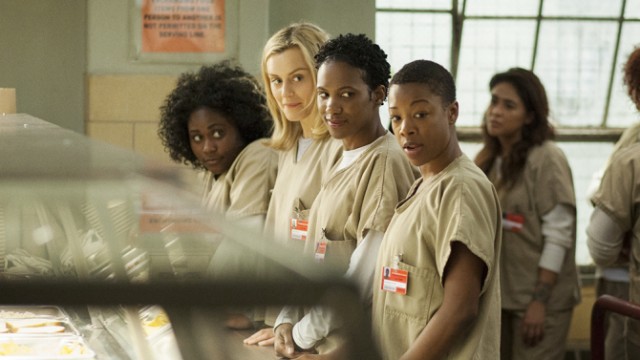The Private Prison Industrial Complex

Caution: “Orange Is The New Black” S3 spoilers ahead.
If Season 3 of Netflix’s dark comedy “Orange Is The New Black” has taught us anything, it’s that the only thing worse than a state-managed prison is a privately managed one. The Times recap explains:
the prison-industrial complex itself is the villain.
Slowly being crushed to death within the gears of the federal prison machine is Joe Caputo, assistant to the warden, who is desperately trying to keep Litchfield a vaguely acceptable place to inhabit for both inmates and employees alike. His efforts, however, are continually quashed by MCC, the privatized company now in charge of the prison’s management. Where in earlier seasons, Litchfield suffered under budgetary restrictions thanks to lack of funding and embezzlement, now corners are cut in order to turn a profit for a private company. As if that weren’t enough to turn one’s stomach, MCC is also outsourcing inmates’ labor to a lingerie company, effectively opening a federally subsidized sweatshop within prison walls.
How much of this is exaggeration for comedic or dramatic effect? Not much. Private prisons remain a billion dollar business in this country, even though they are widely acknowledged to be terrible in predictable ways:
Washington’s contract with the GEO Group is part of the boom in for-profit prisons, whose inmate population increased by 1,600 percent from 1980 to 2009. The privatization of prisons and prison services accelerated during former President Bill Clinton’s administration based on promises of cost savings and better treatment for inmates. For-profit prisons have delivered on neither.
Government-run prisons frequently fail in rehabilitation, in providing medical care and in protecting prisoners from abuse. But private prisons do worse. Poorly paid and inadequately trained guards make for-profit prisons dangerous for staff and prisoners alike. In a 2001 study, the National Council on Crime and Delinquency (NCCD) reported a higher incidence of assaults on prisoners by guards at private prisons than in state and federal prisons.
The U.S. Constitution prohibits cruel or unusual punishment of inmates. Increasingly, private prisons fail to meet even that minimal standard. One egregious example is the Bureau of Prisons’ contracts that require 10 percent of private prison beds to be set aside for solitary confinement. Because private prisons profit from keeping all beds full, this results in overuse and abuse of solitary confinement. This includes instances where immigrant mothers were punished with solitary confinement for protesting deplorable conditions at detention centers.
Even Arizona, a state with such deep-seated law-and-order leanings that it tolerated bumbling cartoon sheriffs Richard Mack and Joe Arpaio for decades, is calling for reform and oversight of its for-profit penal system. What, after all, they wonder, are the taxpayers getting for their money? Riots, violence, and general incompetence, some of which even ends up imperiling ordinary people:
In 2010, three inmates broke out of the same Kingman prison and went onto to murder a couple camping in New Mexico.
“Why is this happening just a few years later at the exact same facility that we’re supposed to be watching so much more closely now?” Meyer said.
Then, earlier this year, the Associated Press reported an inmate at the facility was beaten, sexually assaulted and eventually died. Emergency responders weren’t notified for nearly two hours. His family filed a $7.5 million legal claim against the state.
To be fair, taxpayers also sometimes get panties. It’s true! As we’ve seen on this season of OITNB, for-profit prisons are happy to turn inmates into sweatshop workers, producing underwear, T-shirts, and office equipment for mass consumption.
Faced with these grim realities, Columbia University recently made headlines by deciding to divest:
Citing the “ongoing discussion of the issue of mass incarceration,” Columbia University has decided to stop investing money in companies that run private prisons, becoming the first university in the United States to divest from the controversial industry. …
The $5 billion private prison industry has taken off in recent years, with the number of inmates serving sentences in for-profit prisons doubling between 2000 and 2010. Private prisons house nearly 20 percent of federal prisoners and about 7 percent of state prisoners. Minorities who are convicted of crimes are more likelyto be sent to private prisons than their white counterparts. For-profit prison companies have guaranteed shareholders certain occupancy levels, and to boost occupancy prisons sometimes doled out infractions that lengthen prisoners’ sentences or worked with groups like the American Legislative Exchange Council to enact policies that result in higher rates of incarceration.
Yay! Now if only the Federal and all our State governments would divest too. Then we’d be getting somewhere.
There are lots more fun plot points from the show that we could discuss, including all the labor organizing going on — among staff and inmates, not to mention Piper becoming a dirty panty prison entrepreneur. Have enough people watched at this point that we can make a date and talk?
Support The Billfold
The Billfold continues to exist thanks to support from our readers. Help us continue to do our work by making a monthly pledge on Patreon or a one-time-only contribution through PayPal.
Comments